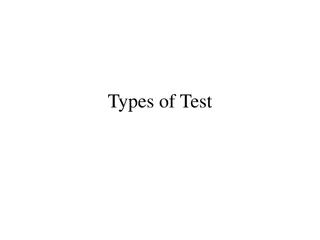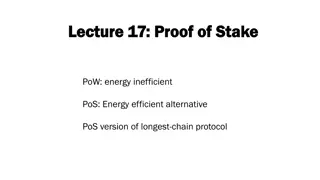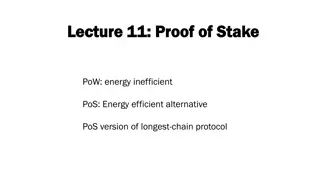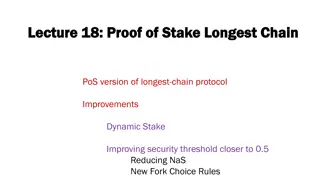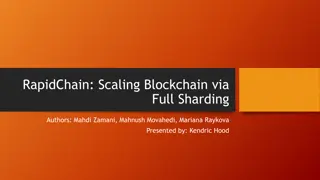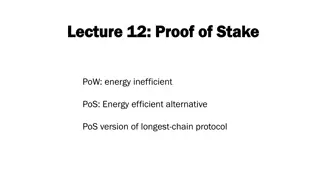
Analysis of Sharding-Based Proof-of-Stake Blockchain Security
Dive into the security analysis of sharding-based Proof-of-Stake blockchain protocols. Learn about a probabilistic model that assesses the likelihood of faulty blocks and the system's longevity. Explore the network structure, committee operations, and fault verification processes. Discover how committee sizes impact security measures and the chain's resilience to faults.
Download Presentation

Please find below an Image/Link to download the presentation.
The content on the website is provided AS IS for your information and personal use only. It may not be sold, licensed, or shared on other websites without obtaining consent from the author. If you encounter any issues during the download, it is possible that the publisher has removed the file from their server.
You are allowed to download the files provided on this website for personal or commercial use, subject to the condition that they are used lawfully. All files are the property of their respective owners.
The content on the website is provided AS IS for your information and personal use only. It may not be sold, licensed, or shared on other websites without obtaining consent from the author.
E N D
Presentation Transcript
Sharding-Based Proof-of- Stake Blockchain Protocols: Security Analysis Abdelatif Hafid, AbdelhakimSenhaji Hafid, Adil Senhaji
Goal Unlike Proof-of-Work models, there are relatively few ways to determine the security of systems using Proof-of-Stake. As such, they develop a probabilistic model to analyze security for sharding-based PoSblockchain systems. The mathematical model computes probability of committing a faulty block and then gives the # of years for the system to fail.
Visualization of Model
The network contains a single beacon chain and shard chains. Each of the shard chains work in parallel and are synchronized by the beacon chain. Each shard has their own committee which is assigned by the beacon chain. Probabilistic Model Each committee processes transactions that belong to the shard. When a new block is created the beacon committee verifies the block. If it is valid, the committee adds the bl0ck header to the beacon chain. If not, then they drop the block and send proof to the shards to vote on whether the corresponding shard s committee should be removed. Each epoch has the beacon chain shuffle committees.
Faulty Block Committing In order for a faulty block to be committed, it must be verified by at least 2/3 of a shard s committee members, at least 2/3 of the beacon s committee members, and by at least 2/3 of all shard s committees.
Results & Evaluation Network has Users = 2000, Validators in a shard = 200, Validators in beacon chain = 400, beacon/committee resiliency =0.333. Shard resiliency = 0.1, 0.2, and 0.3. Probability of committing a faulty block decreases as committee size increases.
Chance for all shards to commit a faulty block Decreases as size of the committee increases
Chance of beacon chain to commit Also decreases as committee size increases.
Time to fail Scenario 1: N = 2000, = 8, V = 200, V = 400, r = r = 0.333 Scenario 2: N = 4000, = 8, V = 400, V = 800, r = r = 0.333
Conclusion By adjusting size of a shard s committee, as well as the size of the beacon s committee, Blockchain systems can be guarded against malicious nodes.



